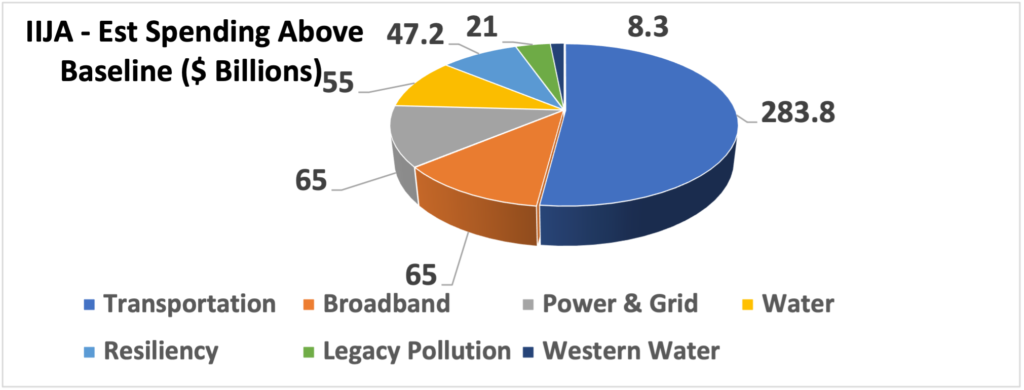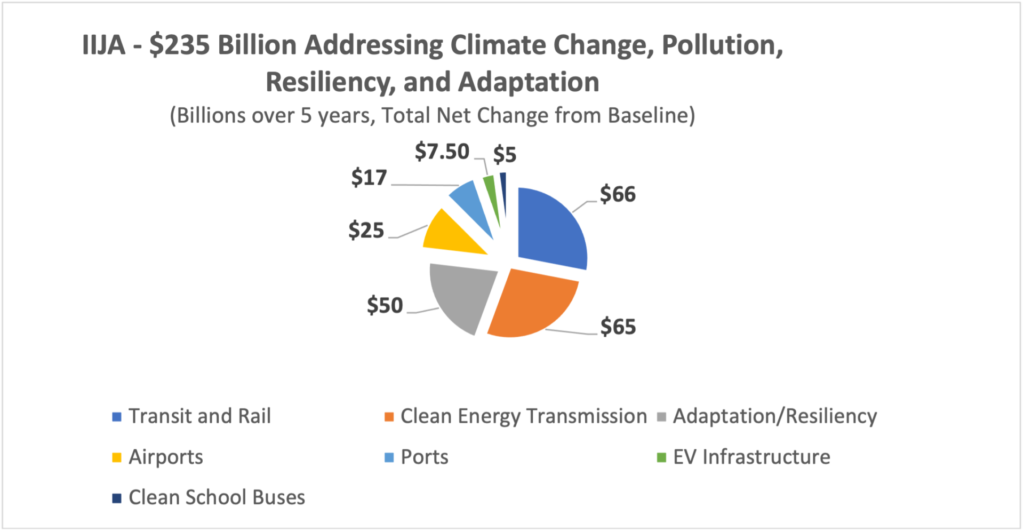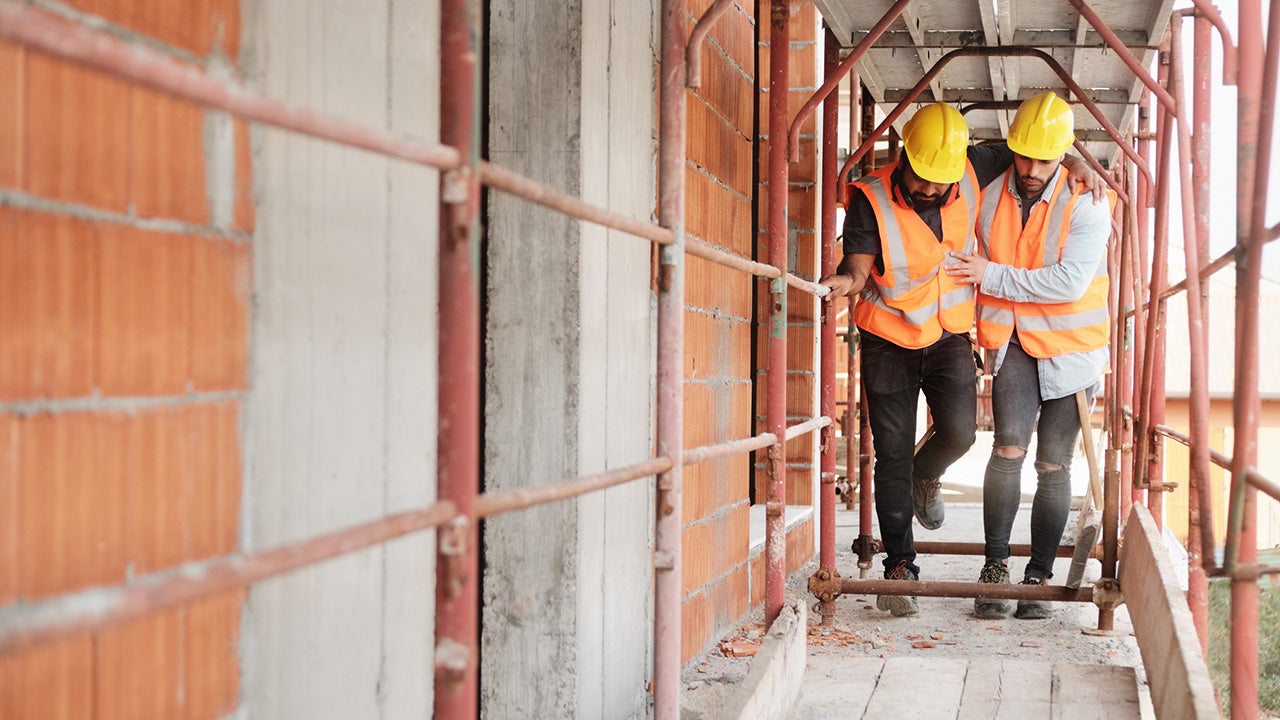While signing the hard-fought infrastructure bill into law, President Biden gave a speech that claimed a legislative accomplishment and staked a place in history. “Generations from now, people will look back and know this is when America won the economic competition for the 21st century,” he said.
The law, formally known as the Infrastructure Investment and Jobs Act (IIJA), centers around infrastructure but encompasses far more. Beyond traditional items such as roads, bridges, transit, and water treatment plants, provisions were included to address climate change, cut and clean up pollution, deliver broadband services, create good jobs, offer worker training, improve racial equity, and spread economic opportunities to those who historically have been left behind. As we kick off this “once in a generation investment” of $1.2 trillion over five years, can we leverage this opportunity to ensure America’s workers will also be winners?
Spending on climate change translates to job opportunities
Despite the big $1.2 trillion total, most funding from the infrastructure package goes to existing programs. The new law nearly doubles current spending adding $550 billion beyond base budgets. The forecasts for job creation are large and consistent. The Economic Policy Institute projects 772,000 jobs per year while Moody Analytics predicts 600,000 in 2024 scaling to 800,000 jobs by 2025.

Source- Fact Sheet: Bipartisan Infrastructure Deal, The White House, Nov 6, 2021
Over half of the new funding is going to Transportation and Related Projects. The next largest categories are Broadband (12%), Power & Grid (12%), Water (10%), and a new area dubbed Resiliency (9%). At just over $47 billion, this latter category ranges from cybersecurity for critical infrastructure to flood and wildlife mitigation, drought and coastal resiliency, ecosystem restoration, heat stress, and weatherization. The IIJA’s advocates are trying to achieve new goals beyond those associated with traditional programs. As the Institute’s Economic Opportunities Program noted last year, these investments are also a unique opportunity to align public spending with higher job quality as well as accessible and inclusive opportunities for all.

Sources- Fact Sheet: Bipartisan Infrastructure Deal, The White House, Nov 6, 2021; Fact Sheet: Biden-Harris Administration Delivering Results 100 Days Into Infrastructure Implementation, The White House, Feb 23, 2022; How States Can Use the Bipartisan Infrastructure Law to Enhance Their Climate Action Efforts, Meredith Alexander et al, Center for American Progress
Yet beyond traditional infrastructure, there are new opportunities in the key area of climate change. Substantial provisions in the law support clean energy sources and smart grid projects as experts suggest transmission capacity must increase by at least 60% by the end of the decade to enable a net-zero emissions electricity system. Transit and rail systems may dampen carbon emissions generated by our existing transportation system that is reliant on personal vehicles. Current programs to reduce household energy burdens that also impact air pollution and the climate were increased by $3.5 billion which will assist low-income families. $5 billion is newly available for schools to replace polluting diesel buses with electric and low emissions buses, helping kids and their communities breathe cleaner air. These investments will drive the creation of jobs from construction to engineering, trucking, architecture, steelwork, and a multitude of other industries.
Still, the question remains: will these investments create good jobs? The 750,000-800,000 jobs from the IIJA are a big deal for the economy and our workforce. But generating good jobs for a diverse and inclusive workforce is mission-critical. Training investments and job standards applied through the public procurement system for purchasing goods and services can safeguard and bolster job quality.
Progress for good jobs and an inclusive workforce
The lion’s share of the infrastructure package’s funds will flow through grants and contracts to purchase goods and services from the private sector. Although there are too many poor-quality jobs in the economy overall, public funding spent through public procurement and for public works supports better jobs. This is due to provisions of the federal Davis-Bacon Act and comparable state requirements. Under these laws, public work projects must pay local prevailing wages to workers. Bidding companies cannot succeed simply by undercutting wages to generate lower project costs.
The infrastructure law also supports creating centers run through partnerships between employers and unions to train workers on the installation and maintenance of energy-efficient building technologies. Surface transportation funds can support registered apprenticeship or pre-apprenticeship programs. And labor management training and apprenticeship programs have a long history of delivering good quality training leading to high-quality jobs that also buttress workers’ protections and rights.
Minority- and women-owned businesses will also gain from IIJA contracting and generally foster jobs, wealth creation, and local economic growth. Longstanding federal, state, and local government procurement provisions ensure a more equitable distribution of contracts and benefits. Contracting targets, which apply in much of the IIJA spending, and other supports have helped boost awards for minority-owned firms to about 10% of all federal contract dollars. That’s roughly $50 billion in contracts to Small Disadvantaged Businesses. Additionally, an amendment to the IIJA strengthened minority contracting by making the Commerce Department’s Minority Businesses Development Agency permanent. The change will increase programming and outreach as well as facilitate the opening of regional offices and rural business centers.
Beyond this, the Biden administration announced its commitment to Justice40 early on. This “whole-of-government” effort aims to deliver at least 40% of the overall benefits from federal investment in climate and clean energy to disadvantaged communities. Those benefits could range from a healthier environment and better protection from devastating weather patterns, to jobs and business opportunities for disadvantaged communities. However, the Justice40 Initiative is in development to translate the broad objective into key definitions, targets, regulations, and tools. Worker and workforce advocates as well as states and local communities must engage with the White House and agencies to make good on the promise.
Implementation must be shaped by local organizing and advocacy
To maximize this momentum for change, communities, workers, unions, business leaders, policymakers, and their allies should advocate that these resources create good jobs and inclusive opportunities. Organizing and planning are needed to hold agencies, officials, employers, and project sponsors accountable. The time is now to expand this work, as infrastructure spending will launch many large projects that must be planned, assessed, and approved. Local support or opposition can be a deciding or influential factor. This magnifies opportunities for community and worker stakeholders to negotiate Community Benefit Agreements.
Community Benefit Agreements detail the benefits that the employer or project will provide. In return, the community supports project approval and may help their partner in specific ways. For example, funds for public transit and transportation projects can be leveraged to secure job quality, local hiring, training opportunities, and pathways to good jobs for underrepresented communities. Community partners, in return, may commit to recruiting workers, delivering training, and offering supportive services to improve retention and advancement.
The Infrastructure Investment and Jobs Act is a major accomplishment that addresses a backlog of needed repairs while also ensuring essential investments in our nation’s climate-resilient future. It expands opportunities to address job quality and equity goals. But legislation cannot address all contingencies. Implementation could lead to a patchwork of good, indifferent, and poor uses of these resources. Communities have the power to steer this historic investment toward the effective and equitable implementation that our future requires.
This piece is part of In Focus: Rising to the Climate Challenge, a multimedia informational campaign that draws on the expertise of Institute programs. We look at four main facets of the climate change issue—labor and the economy, youth and education, public health and safety, and communities. To get campaign updates and other news from the Aspen Institute in your inbox, sign up for our newsletter.


